Cherry Blossom CBG
RSP 11303
Grower: Yabba Cannaba
General Information
- Sample Name
- CJ2
- Accession Date
- October 16, 2019
- Reported Plant Sex
- Female
- Report Type
- StrainSEEK v2 3.2Mb
- DNA Extracted From
- Stem
The strain rarity visualization shows how distant the strain is from the other cultivars in the Kannapedia database. The y-axis represents genetic distance, getting farther as you go up. The width of the visualization at any position along the y-axis shows how many strains there are in the database at that genetic distance. So, a common strain will have a more bottom-heavy shape, while uncommon and rare cultivars will have a visualization that is generally shifted towards the top.
Chemical Information
Cannabinoid and terpenoid information provided by the grower.
Cannabinoids
No information provided.
Terpenoids
No information provided.
Genetic Information
- Plant Type
- Type III
File Downloads
The bell curve in the heterozygosity visualization shows the distribution of heterozygosity levels for cannabis cultivars in the Kannapedia database. The green line shows where this particular strain fits within the distribution. Heterozygosity is associated with heterosis (aka hybrid vigor) but also leads to the production of more variable offspring. When plants have two genetically different parents, heterozygosity levels will be higher than if it has been inbred or backcrossed repeatedly.
The ratio of reads mapped to Y-contigs to reads mapped to the whole Cannabis genome (Y-ratios) has been demonstrated to be strongly correlated with plant sex typing. This plot shows the distribution of Y-ratios for all samples in our database which were sequenced with the same method (panel or WGS) as this sample and where this sample falls in the distribution.
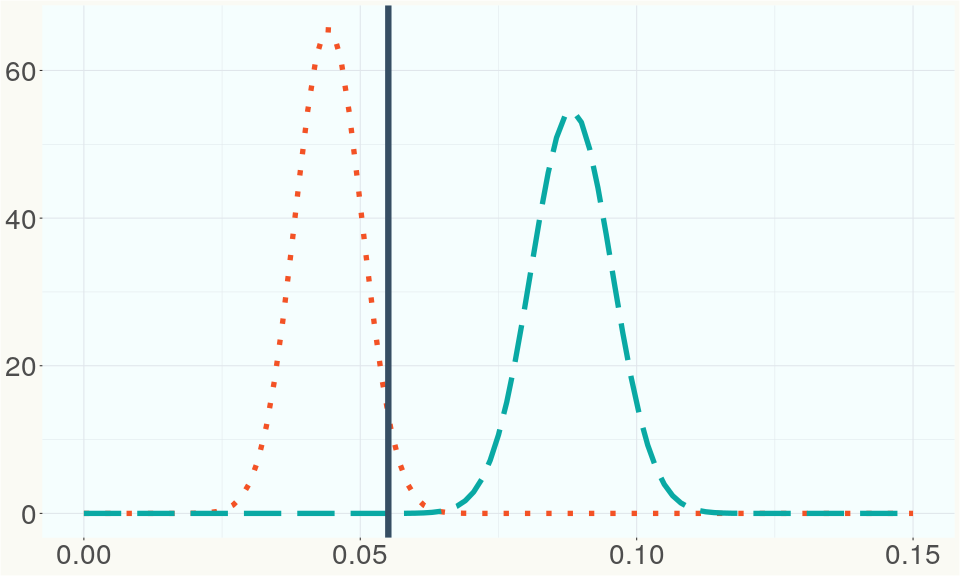
This chart represents the Illumina sequence coverage over the Bt/Bd allele. These are the three regions in the cannabis genome that impact THCA, CBDA, CBGA production. Coverage over the Active CBDAS gene is highly correlated with Type II and Type III plants as described by Etienne de Meijer. Coverage over the THCA gene is highly correlated with Type I and Type II plants but is anti-correlated with Type III plants. Type I plants require coverage over the inactive CBDA loci and no coverage over the Active CBDA gene. Lack of coverage over the Active CBDA and Active THCA allele are presumed to be Type IV plants (CBGA dominant). While deletions of entire THCAS and CBDAS genes are the most common Bt:Bd alleles observed, it is possible to have plants with these genes where functional expression of the enzyme is disrupted by deactivating point mutations (Kojoma et al. 2006).
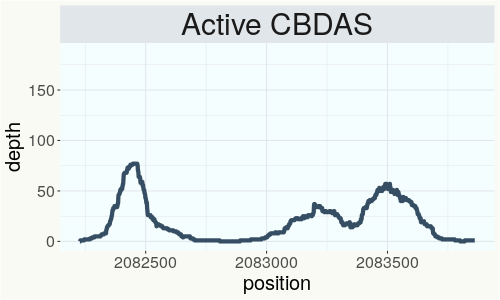
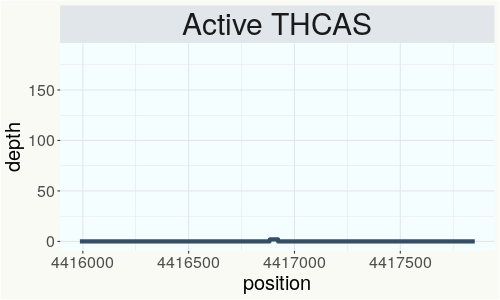
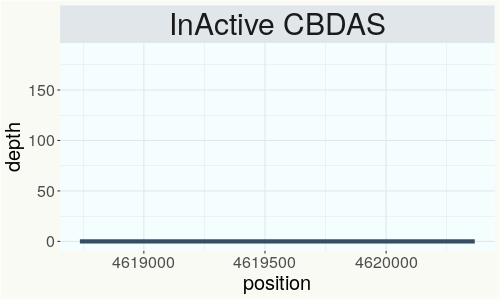
This chart represents the Illumina sequence coverage over the CBCA synthase gene.
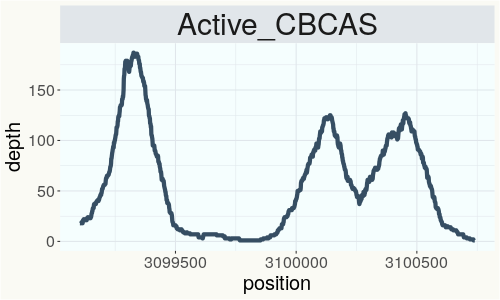
Variants (THCAS, CBDAS, and CBCAS)
No variants to report
Variants (Select Genes of Interest)
| PKSG-2a | c.67T>A | p.Phe23Ile | missense variant | moderate | contig700 | 1945567 | A/T | |
| PKSG-2a | c.31A>T | p.Thr11Ser | missense variant | moderate | contig700 | 1945603 | T/A | |
| PKSG-2b | c.1132C>G | p.Leu378Val | missense variant | moderate | contig700 | 1950506 | G/C |
|
| PKSG-2b | c.1117A>G | p.Ile373Val | missense variant | moderate | contig700 | 1950521 | T/C | |
| PKSG-2b | c.31A>T | p.Thr11Ser | missense variant | moderate | contig700 | 1951851 | T/A | |
| PKSG-4b | c.496A>G | p.Lys166Glu | missense variant | moderate | contig700 | 2721177 | T/C | |
| PKSG-4b | c.489delT | p.Phe163fs | frameshift variant | high | contig700 | 2721183 | CA/C | |
| PKSG-4b | c.485A>G | p.Lys162Arg | missense variant | moderate | contig700 | 2721188 | T/C | |
| PKSG-4b | c.431T>G | p.Val144Gly | missense variant | moderate | contig700 | 2721242 | A/C | |
| PKSG-4b | c.419A>G | p.Asp140Gly | missense variant | moderate | contig700 | 2721254 | T/C | |
| PKSG-4b |
c.352_355del |
p.Thr118fs | frameshift variant | high | contig700 | 2721317 | CCTGT/C |
|
| PKSG-4b | c.323A>G | p.Glu108Gly | missense variant | moderate | contig700 | 2721350 | T/C |
|
| DXR-2 | c.1319T>C | p.Ile440Thr | missense variant | moderate | contig380 | 285250 | A/G |
|
| aPT4 | c.97T>C | p.Tyr33His | missense variant | moderate | contig121 | 2828753 | T/C |
|
| aPT4 |
c.235_236del |
p.Val79fs | frameshift variant | high | contig121 | 2829030 | ATG/A |
|
| aPT4 | c.238delT | p.Ser80fs | frameshift variant | high | contig121 | 2829034 | AT/A |
|
| aPT4 | c.302A>G | p.Asn101Ser | missense variant | moderate | contig121 | 2829099 | A/G |
|
| aPT4 |
c.744+1_744+ |
splice donor variant & splice region variant & intron variant | high | contig121 | 2831022 |
GGTAATTTATTT |
|
Nearest genetic relatives (All Samples)
- 0.170 Unknown--Cherry Wine---004- (RSP11271)
- 0.173 Cherry Blossom (RSP11320)
- 0.185 Cherry Blossom (RSP11306)
- 0.194 Unknown--Cherry Wine---005- (RSP11272)
- 0.197 Cherry Blossom (RSP11299)
- 0.205 Cherry Blossom (RSP11315)
- 0.210 Cherry Blossom (RSP11309)
- 0.210 Cherry Blossom (RSP11325)
- 0.212 Cherry Blossom (RSP11313)
- 0.213 Sparrow (RSP11443)
- 0.215 Cherry Blossom (RSP11329)
- 0.219 Cherry Blossom (RSP11304)
- 0.220 Cherry Blossom (RSP11332)
- 0.227 Cherry Blossom (RSP11316)
- 0.228 Cherry Blossom (RSP11298)
- 0.234 Electra (RSP11366)
- 0.236 Cherry Blossom (RSP11330)
- 0.238 Cherry Blossom (RSP11322)
- 0.242 Lift (RSP11378)
- 0.243 Rest (RSP11377)
Most genetically distant strains (All Samples)
- 0.459 JL#2 (RSP11076)
- 0.448 RKM-2018-022 (RSP11114)
- 0.446 White Label 1 (RSP11336)
- 0.443 Cherry Blossom (RSP11318)
- 0.440 Chematonic -Cannatonic x Chemdawg- (RSP11394)
- 0.436 Queen Dream CBG (RSP11287)
- 0.435 JL 4th Gen 2 (RSP11194)
- 0.430 Hindu Kush (SRR14708261)
- 0.430 CS (RSP11208)
- 0.428 B52 (SRR14708255)
- 0.427 Northern Lights (RSP11501)
- 0.426 R1in136 (SRR14708227)
- 0.426 BagSeed (RSP12501)
- 0.424 R1in136 (SRR14708226)
- 0.423 Alpine Rocket (SRR14708266)
- 0.423 Tangerine Haze (RSP10995)
- 0.423 BagSeed (RSP12627)
- 0.423 Abacus (RSP11266)
- 0.423 Dave Pineapple (RSP11626)
- 0.422 JL yellow (RSP11075)
Nearest genetic relative in Phylos dataset
- Overlapping SNPs:
- 63
- Concordance:
- 36
Nearest genetic relative in Lynch dataset
- Overlapping SNPs:
- 3
- Concordance:
- 3
Blockchain Registration Information
- Transaction ID
-
335520f02423995a
c9541f03afeb33f3 dd1a2f46395d9a01 ef66b7a3b854e866 - Stamping Certificate
- Download PDF (861.8 KB)
- SHASUM Hash
-
39a974d2d387cbfd3f24f2d651c178e6 4dfe81ade46113ee 8ea74f8ca7ff57da